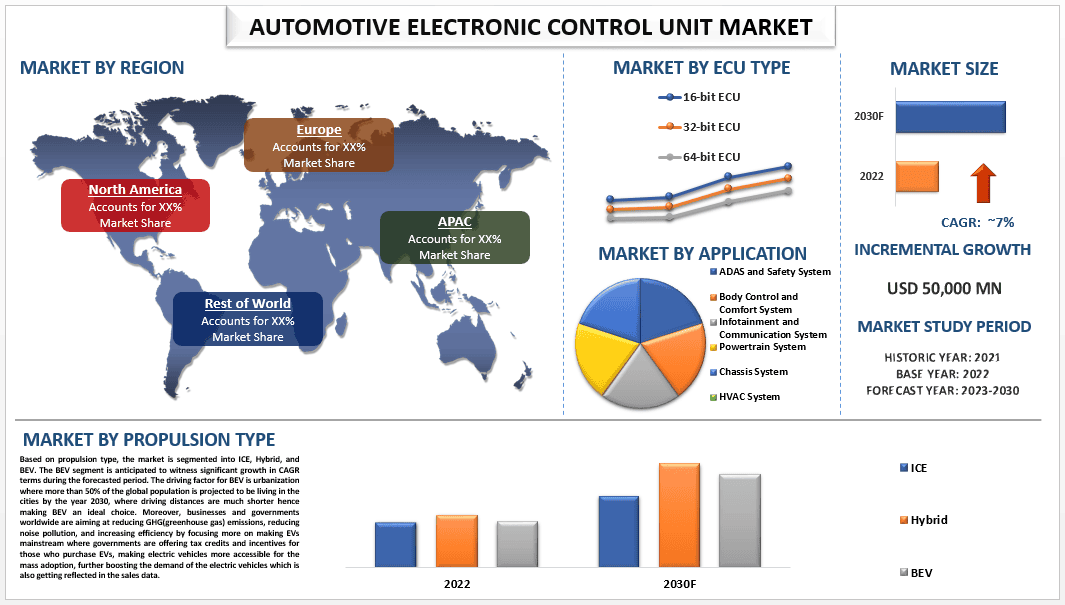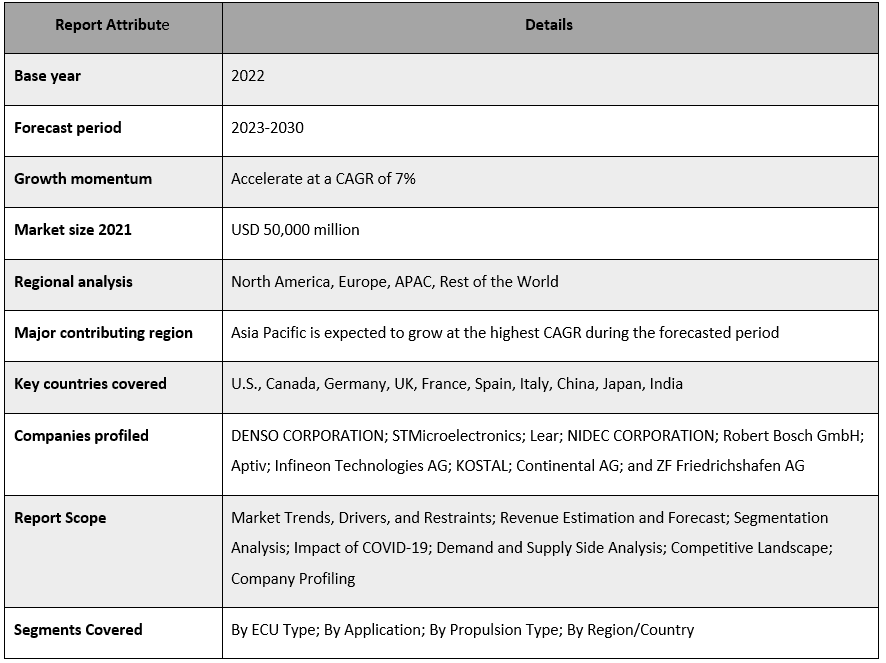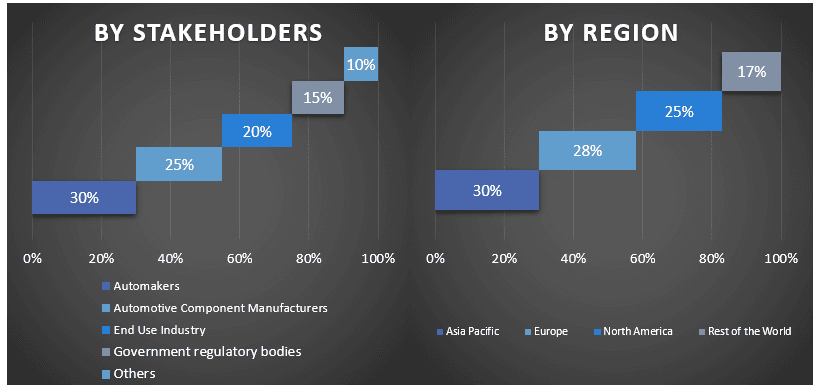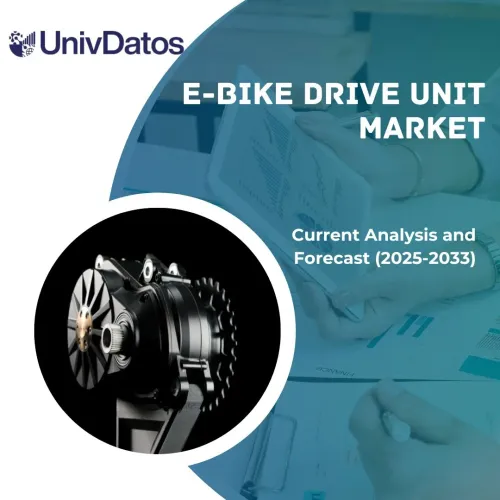Рынок автомобильных электронных блоков управления: текущий анализ и прогноз (2023-2030)
Акцент на типе (ECU менее 16 бит, ECU 32 бита и ECU 64 бита), Применение (ADAS и системы безопасности, Системы управления кузовом и комфорта, Информационно-развлекательная и коммуникационная система, Системы трансмиссии, Система шасси и системы HVAC), Тип привода (ДВС, гибрид и BEV), Регион/Страна

Объем рынка автомобильных электронных блоков управления оценивается в 50 миллиардов долларов США в 2022 году и, по прогнозам, будет расти со среднегодовым темпом роста в 7% с 2023 по 2030 год. Автомобильный электронный блок управления (ECU) — это система на основе микроконтроллера, которая управляет различными электрическими и электронными функциями в современных транспортных средствах. Он служит мозгом электронных систем автомобиля, координируя и контролируя работу многочисленных компонентов и подсистем. Кроме того, ECU отвечают за мониторинг и контроль различных аспектов работы автомобиля, включая управление двигателем, управление трансмиссией, тормозные системы, системы подвески, климат-контроль, системы безопасности и многое другое. Они получают входные данные от многочисленных датчиков, расположенных по всему автомобилю, обрабатывают данные и выдают команды соответствующим приводам или компонентам для достижения желаемой функциональности. Основными факторами, определяющими рост рынка автомобильных электронных блоков управления, являются увеличение электрификации автомобилей, которое обусловлено ростом спроса на электромобили, что привело к значительному увеличению количества ECU, необходимых для каждого автомобиля, где управление электрической трансмиссией, управление батареями, рекуперативное торможение и другие передовые функции требуют использования нескольких ECU, что стимулирует рост рынка. Кроме того, растет внимание к повышению безопасности автомобилей, что привело к интеграции передовых систем помощи водителю (ADAS) и активных функций безопасности. Эти системы полагаются на ECU для обработки данных датчиков и принятия решений в режиме реального времени, что способствует внедрению ECU в автомобили. Более того, разработка и внедрение технологий автономного вождения значительно повысили спрос на ECU. Автономные транспортные средства требуют многочисленных ECU для управления различными функциями, такими как восприятие, принятие решений и привод, что стимулирует рост рынка ECU. Кроме того, потребители теперь ожидают расширенных возможностей подключения, информационно-развлекательных систем и развлекательных опций в автомобиле. Эти системы в значительной степени полагаются на ECU для управления такими функциями, как навигация, мультимедиа, интеграция со смартфонами и беспроводная связь, что способствует росту рынка ECU. Это также можно увидеть из последних разработок и инноваций, происходящих в этой области. Например, в октябре 2022 года компания ACTIA запустила интеллектуальную информационно-развлекательную систему и бортовую систему управления под названием ACTiVi. Этот ECU подключен к дисплею и управляет всеми функциями автомобиля. Компания объявила о запуске в ответ на массовый приток мультимедийных систем в пассажирские транспортные средства.
К основным игрокам, работающим на рынке, относятся DENSO CORPORATION; STMicroelectronics; Lear; NIDEC CORPORATION; Robert Bosch GmbH; Aptiv; Infineon Technologies AG; KOSTAL; Continental AG; и ZF Friedrichshafen AG
Аналитическая информация, представленная в отчете
«Ожидается, что среди типов ECU сегмент 64-битных ECU станет свидетелем значительного роста CAGR в течение прогнозируемого периода».
На основе типа ECU рынок сегментирован на ECU ниже 16-битных, 32-битные ECU и 64-битные ECU. Ожидается, что 64-битные ECU продемонстрируют значительный рост в терминах CAGR. Основными факторами, которые будут стимулировать этот рост, является переход транспортных средств от почти полного отсутствия автономности к некоторому уровню автономности, а затем и к полностью автономным транспортным средствам. А вычислительная мощность, необходимая для достижения любого уровня автономности, может быть эффективно реализована только 64-битными ECU.
«Среди типов двигателей ожидается, что сегмент BEV будет расти со значительным среднегодовым темпом роста в течение прогнозируемого периода».
На основе типа двигателя рынок сегментирован на ICE, Hybrid и BEV. Ожидается, что сегмент BEV станет свидетелем значительного роста в терминах CAGR в течение прогнозируемого периода. Движущим фактором для BEV является урбанизация, когда, по прогнозам, к 2030 году более 50% населения мира будет жить в городах, где расстояния для вождения намного короче, что делает BEV идеальным выбором. Более того, предприятия и правительства во всем мире стремятся сократить выбросы парниковых газов, снизить шумовое загрязнение и повысить эффективность, уделяя больше внимания тому, чтобы сделать электромобили мейнстримом, где правительства предлагают налоговые льготы и стимулы для тех, кто приобретает электромобили, делая электромобили более доступными для массового внедрения, что еще больше повышает спрос на электромобили, что также отражается в данных о продажах. Например, по данным Международного энергетического агентства (МЭА), потребители потратили 120 миллиардов долларов США на покупку электромобилей в 2020 году, что на 50% больше, чем в 2019 году, что выражается в увеличении продаж на 41% и росте средних цен на 6%.
Охват отчета о рынке автомобильных электронных блоков управления

«Азиатско-Тихоокеанский регион доминировал на рынке автомобильных электронных блоков управления в 2022 году».
Азиатско-Тихоокеанский регион занимает большую часть доли рынка, а также готов стать свидетелем значительного роста в терминах CAGR в течение прогнозируемого периода. Ожидается, что рынок автомобильных электронных блоков управления в Азиатско-Тихоокеанском регионе станет свидетелем значительного роста в течение прогнозируемого периода. Благодаря росту ВВП на душу населения стран Азиатско-Тихоокеанского региона, что повышает уровень жизни и увеличивает количество денег в руках людей, стимулируя потребление в странах. Кроме того, высокий спрос на электромобили в этих регионах также является одним из основных факторов повышенного спроса на ECU. Хотя в процентах от общего количества проданных автомобилей процент электромобилей является самым высоким в Европе. Тем не менее, количество проданных единиц в Китае лидирует и превратился в ведущего производителя и продавца электромобилей в мире. По прогнозам, азиатские страны произведут почти 13 миллионов электромобилей в 2023 году, тогда как в 2022 году Китай продал примерно 52% от общего количества электромобилей, произведенных в мире, что составляет почти 3,5 миллиона единиц. В Индии это число в настоящее время составляет одну треть миллиона единиц и продемонстрировало устойчивый рост почти на 168% в годовом исчислении. Кроме того, развивающиеся экономики также являются одним из крупнейших рынков из-за их огромного населения с постепенно растущим ВВП на душу населения, и с ростом осведомленности, поддержкой правительств и отличными предложениями от OEM-производителей с точки зрения цены и продукта в дальнейшем развивается среда высокого роста для сегмента электромобилей в регионе APAC. Например, в январе 2023 года министр-координатор по экономическим вопросам Индонезии объявил о выделении 320 миллионов долларов США из бюджета этого года на предоставление субсидий на электромобили.
Причины купить этот отчет:
- Исследование включает в себя анализ размера рынка и прогнозирования, подтвержденный проверенными ключевыми экспертами отрасли.
- В отчете представлен краткий обзор общих показателей отрасли с первого взгляда.
- В отчете представлен углубленный анализ известных игроков отрасли с упором на ключевые финансовые показатели бизнеса, портфели продуктов, стратегии расширения и последние разработки.
- Подробное изучение драйверов, ограничений, ключевых тенденций и возможностей, преобладающих в отрасли.
- Исследование всесторонне охватывает рынок по различным сегментам.
- Подробный анализ отрасли на региональном уровне.
Варианты настройки:
Глобальный рынок автомобильных электронных блоков управления может быть дополнительно настроен в соответствии с требованиями или любым другим сегментом рынка. Кроме того, UMI понимает, что у вас могут быть свои собственные бизнес-потребности, поэтому не стесняйтесь обращаться к нам, чтобы получить отчет, который полностью соответствует вашим требованиям.
Содержание
Методология исследования для анализа рынка автомобильных электронных блоков управления (2023–2030 гг.)
Анализ исторического рынка, оценка текущего рынка и прогнозирование будущего рынка глобального рынка автомобильных электронных блоков управления были тремя основными этапами, предпринятыми для создания и анализа внедрения автомобильных электронных блоков управления в основных регионах мира. Было проведено исчерпывающее вторичное исследование для сбора исторических рыночных данных и оценки текущего размера рынка. Во-вторых, для проверки этих данных были приняты во внимание многочисленные выводы и предположения. Кроме того, были проведены исчерпывающие первичные интервью с отраслевыми экспертами по всей цепочке создания стоимости глобального рынка автомобильных электронных блоков управления. После предположений и проверки рыночных данных посредством первичных интервью мы использовали восходящий/нисходящий подход для прогнозирования общего размера рынка. После этого были приняты методы декомпозиции рынка и триангуляции данных для оценки и анализа размера рынка сегментов и подсегментов соответствующей отрасли. Подробная методология описана ниже:
Анализ исторического размера рынка
Шаг 1: Углубленное изучение вторичных источников:
Было проведено подробное вторичное исследование для получения исторических данных о размере рынка автомобильных электронных блоков управления через внутренние источники компании, такие как годовые отчеты и финансовые отчеты, презентации результатов деятельности, пресс-релизы и т. д., и внешние источники, включая журналы, новости и статьи, правительственные публикации, публикации конкурентов, отраслевые отчеты, сторонние базы данных и другие надежные публикации.
Шаг 2: Сегментация рынка:
После получения исторических данных о размере рынка автомобильных электронных блоков управления мы провели подробный вторичный анализ для сбора исторических рыночных данных и долей для различных сегментов и подсегментов в основных регионах. Основные сегменты, включенные в отчет, сгруппированы по типу ЭБУ, по применению и по типу силовой установки. Кроме того, был проведен анализ на уровне стран для оценки общего внедрения моделей тестирования в этом регионе.
Шаг 3: Факторный анализ:
После получения исторических данных о размере рынка различных сегментов и подсегментов мы провели подробный факторный анализ для оценки текущего размера рынка автомобильных электронных блоков управления. Кроме того, мы провели факторный анализ с использованием зависимых и независимых переменных, таких как тип ЭБУ, применение и тип силовой установки автомобильных электронных блоков управления. Был проведен тщательный анализ сценариев спроса и предложения с учетом ведущих партнерств, слияний и поглощений, расширения бизнеса и запуска продуктов в секторе рынка автомобильных электронных блоков управления по всему миру.
Оценка и прогноз текущего размера рынка
Определение текущего размера рынка: На основе практически применимых данных, полученных на основе вышеуказанных 3 шагов, мы определили текущий размер рынка, ключевых игроков на глобальном рынке автомобильных электронных блоков управления и рыночные доли сегментов. Все необходимые процентные доли разделения и разбивки рынка были определены с использованием вышеупомянутого вторичного подхода и проверены посредством первичных интервью.
Оценка и прогнозирование: Для оценки и прогнозирования рынка веса были присвоены различным факторам, включая движущие силы и тенденции, ограничения и возможности, доступные для заинтересованных сторон. После анализа этих факторов были применены соответствующие методы прогнозирования, т. е. восходящий/нисходящий подход, для получения рыночного прогноза на 2030 год для различных сегментов и подсегментов на основных рынках мира. Методология исследования, принятая для оценки размера рынка, включает:
- Размер рынка отрасли с точки зрения выручки (доллары США) и темпы внедрения рынка автомобильных электронных блоков управления на основных рынках внутри страны
- Все процентные доли, разделения и разбивки рыночных сегментов и подсегментов
- Ключевые игроки на глобальном рынке автомобильных электронных блоков управления с точки зрения предлагаемых продуктов. Кроме того, стратегии роста, принятые этими игроками для конкуренции на быстрорастущем рынке
Проверка размера и доли рынка
Первичное исследование: Были проведены углубленные интервью с ключевыми лидерами мнений (KOL), включая руководителей высшего звена (CXO/вице-президенты, руководители отдела продаж, руководители отдела маркетинга, операционные руководители, региональные руководители, руководители стран и т. д.) в основных регионах. Затем результаты первичного исследования были обобщены и был выполнен статистический анализ для доказательства заявленной гипотезы. Входные данные первичного исследования были объединены с вторичными результатами, что превратило информацию в практически применимые данные.
Разделение первичных участников в различных регионах

Инжиниринг рынка
Метод триангуляции данных был использован для завершения общей оценки рынка и получения точных статистических данных для каждого сегмента и подсегмента глобального рынка автомобильных электронных блоков управления. Данные были разделены на несколько сегментов и подсегментов после изучения различных параметров и тенденций в областях типа ЭБУ, применения и типа силовой установки на глобальном рынке автомобильных электронных блоков управления.
Основная цель исследования глобального рынка автомобильных электронных блоков управления
В исследовании были точно определены текущие и будущие рыночные тенденции глобального рынка автомобильных электронных блоков управления. Инвесторы могут получить стратегические данные, чтобы основывать свое решение об инвестициях на качественном и количественном анализе, выполненном в исследовании. Текущие и будущие рыночные тенденции определили общую привлекательность рынка на региональном уровне, предоставив платформу для промышленного участника для использования неиспользованного рынка, чтобы извлечь выгоду из преимущества первопроходца. Другие количественные цели исследований включают:
- Анализ текущего и прогнозируемого размера рынка автомобильных электронных блоков управления с точки зрения стоимости (доллары США). Кроме того, анализ текущего и прогнозируемого размера рынка различных сегментов и подсегментов
- Сегменты в исследовании включают области типа ЭБУ, применения и типа силовой установки.
- Определение и анализ нормативно-правовой базы для индустрии автомобильных электронных блоков управления
- Анализ цепочки создания стоимости с участием различных посредников, а также анализ поведения клиентов и конкурентов отрасли
- Анализ текущего и прогнозируемого размера рынка автомобильных электронных блоков управления для основного региона
- Основные страны регионов, изученные в отчете, включают Азиатско-Тихоокеанский регион, Европу, Северную Америку и остальной мир
- Профили компаний рынка автомобильных электронных блоков управления и стратегии роста, принятые участниками рынка для поддержания устойчивости на быстрорастущем рынке
- Углубленный анализ отрасли на региональном уровне
Связанные Отчеты
Клиенты, купившие этот товар, также купили










